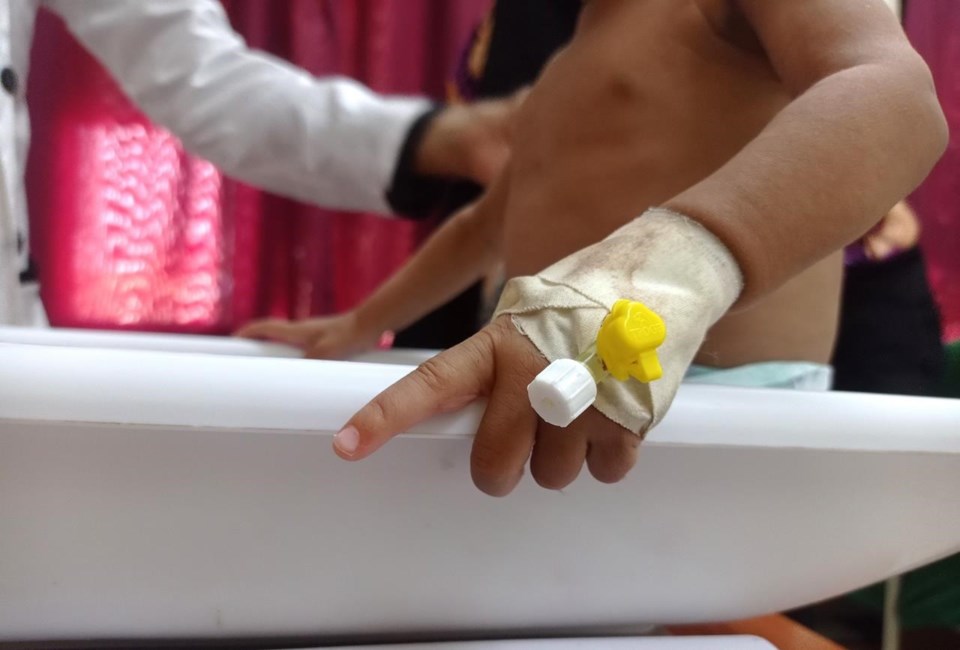HAYS, Yemen (AP) — An emaciated little girl lies motionless on a hospital bed and struggles to breathe. Her body is covered with sores. She can barely open her eyes.
Hafsa Ahmed is about 2. About a dozen other children in the red-brick hospital in this southern Yemeni city are also dying of starvation.
Hunger has long threatened the lives of hundreds of thousands of Yemen’s children. Now, the war between the country’s Iran-backed Houthi rebels and a Saudi-led coalition is threatening to escalate after months of a tenuous truce. Yemenis, and international assistance groups, worry that the situation will get even worse.
In the city of Hodeida, with a population of roughly 3 million, al-Thawra Hospital receives 2,500 patients daily, including “super-malnourished” children, said Joyce Msuya, U.N. assistant secretary-general for humanitarian affairs. She visited the facility this month.
Around 2.2 million Yemeni children under the age of 5 are hungry. More than half a million are severely malnourished. Some 1.3 million pregnant or breastfeeding women had severe malnutrition this year, the United Nations says.
“This is one of the saddest visits I’ve ever done in my professional life,” Msuya said in a video released by the U.N. “There are immense needs. Half of Yemeni hospitals are not functioning, or they are completely destroyed by the war. We need more support to save lives in Yemen, children, women and men.”
The war in Ukraine is exacerbating the situation.
The Yemeni diet depends heavily on wheat. Ukraine supplied Yemen with 40% of its grain, until Russia's invasion cut the flow. In developed countries, people are working harder to pay higher bills. In Yemen, food is 60% more expensive than it was last year. And in poor countries, inflation can mean death.
“Yemen has been hit three times by the Russian invasion of Ukraine," said Peter Salisbury, a Yemen expert at the International Crisis Group. “First, by the loss of food supplies from Ukraine and higher prices on international markets. Then, by higher fuel prices. And third, by a shift in international focus.”
War has raged for eight years in Yemen between Shiite Houthi rebels and pro-government forces backed by a coalition of Sunni Gulf Arab states. The Iran-backed Houthis swept down from the mountains in 2014, occupied northern Yemen and the country's capital, Sanaa, and forced the internationally recognized government to flee into exile to Saudi Arabia.
Since then, more than 150,000 people were killed by the violence and 3 million were displaced. Two-thirds of the population get food assistance.
There's a truce in place now despite the two sides' failure to renew it this month. Hafsa and more than half a million other Yemeni children are severely malnourished. Every 10 minutes, a child in Yemen dies from preventable illness, according to Save the Children.
Hafsa is the youngest of six. One died from malnutrition. Her father Ahmed, 47, works as a day laborer. Each day he can afford only some flour and cooking oil.
He and his family live in the district of Hays, about 120 kilometers (74 miles) south of the port city of Hodeida, which has seen some of the fiercest fighting in Yemen’s conflict.
The children in Hays Hospital have swollen bellies and twig-like limbs. Eventually, prolonged malnutrition “causes their organs to stop functioning,” Dr. Nabouta Hassan said.
Hassan, who oversees the hospital's malnutrition ward, said that every month it receives up to 30 children suffering from diseases related to acute malnutrition.
Hodeida, along with the northern province of Hajjah, includes the hardest-hit areas by extremely severe food insecurity and acute malnutrition, according to the U.N.
Mohammed Hussein, a 49-year-old father of five, lives in a camp for displaced people in the outskirts of the city of Abs in northern Hajjah province.
He said he has been displaced four times since the war began in 2014.
“I lost my home, farmland, everything,” he said over the phone.
He lost a 9-month-old son three years ago. He has a 1-year-old and a 3-year-old who are starving.
Their main dish is bread mixed with water and salt. Some days, neighbors give his family meat, chicken or pasta. Hussein's too poor to take his kids to the hospital.
“There is no money, and I am jobless,” he said. ”They could die also from hunger."
The U.N. food agency has cut rations for millions of people due to critical funding gaps and soaring global food prices. The World Food Program has for months prioritized the most vulnerable 13.5 million Yemenis, according to the U.N. Office for the Coordination of Humanitarian Affairs, or OCHA.
The U.N. said that by the end of September, its humanitarian response plan for Yemen secured $2 billion of the $4.27 billion needed to provide life-saving humanitarian assistance and protection services to 17.9 million people.
Abdulwasea Mohammed, advocacy, media and campaigns manager for Oxfam in Yemen, said his group needs more money, more consistent access to the most vulnerable, and a peaceful resolution to the conflict.
“The response is saving lives every day despite this,” he said.
___
Magdy reported from Cairo.
Anwar Salem And Samy Magdy, The Associated Press




